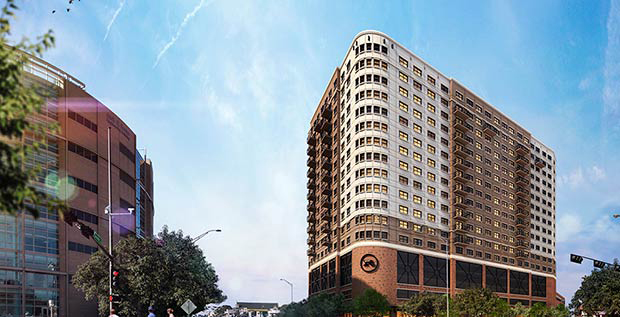Students propose energy-saving plans for new Northgate highrise
Measures to reduce energy use in a high-profile Northgate mixed-use residential development were detailed in construction proposals prepared this spring by construction science students at Texas A&M.
The students used the real world project, [The Rise at Northgate] (http://riseatnorthgate.com) , scheduled for completion in the fall 2013 semester, as a template for an assignment in a “green” construction course led by José Fernández-Solis, associate professor of construction science, exploring the costs and potential benefits of sustainable construction practices.
“The exercise prepared students to become ‘green’ builders by exposing them to requirements, practices, design and scheduling decisions based on financial considerations,” said Solis.
Working in teams, students created proposals that included a construction schedule, cost estimates, risk mitigating strategies and plans to incorporate building information modeling in the project, which will stand 18 stories tall, include 484 bedrooms and add 17,000 square-feet of ground floor retail space on University Avenue when it’s completed in fall 2013.
The proposals included estimates for building the structure to meet [standards] (http://www.usgbc.org/leed) set by the U.S. Green Building Council with modifications that included a green roof, rainwater collection systems and solar panels, and identified construction issues that had to be resolved in schedule, quality control and site logistics.
One group’s “green” approach included using a single air conditioning unit to control room temperatures. Maximum and minimum temperature limits in the apartments could then be set by building management, said the proposal by students, Scott Linn, Daniel Markgraf, Jacob Martin, Jared Minks, David Resendez and Joshua Saldivar, in their proposal.
“This could drastically reduce operating costs,” they said, noting that, “the building’s management could even turn off the air conditioning or heating in empty rooms during the summer and winter sessions.”
Their proposal also calls for using collected rainwater or recycled "gray water" to irrigate the building’s landscaping as well as building materials that don’t emit carcinogens, such as formaldehyde, in the building’s adhesives and sealants, paints, carpets and composite materials.
Another group proposed transportation-related measures to minimize the building’s impact on the environment, such as providing secure bicycle storage for 15-percent of its occupants, and reserving five-percent of the building’s best parking spots for low-emission and fuel-efficient vehicles.
The student team, consisting of Colton Shaw, Chase Shimek, Matthew Smith, Pablo Soberanes and Shane Struska, called for the creation of an administrative unit charged with verifying that the building’s energy-related systems are properly installed, calibrated and performing according to the owner’s project requirements, design and construction documents.
They also proposed the use of environmentally friendly heating and cooling system refrigerants.
Tags
- academics
- building a better texas
- construction science
- energy
- energy sustainability
- environment
- sustainability
- undergraduate work
Related Posts
Grad student's idea wins Mays contest
Students craft useful building software plugins for Revit

Students display tiny homes on campus

Student-designed, built ‘tiny’ homes to house homeless
Follow Us
Facebook Twitter Vimeo Youtube Flickr RSS
Recent Posts

Planning prof heads study of disaster housing aid

A message from the dean

Former student remembered as expert planner

Leading educator named new head of Architecture Dept.






_thumbnail_small.png)
